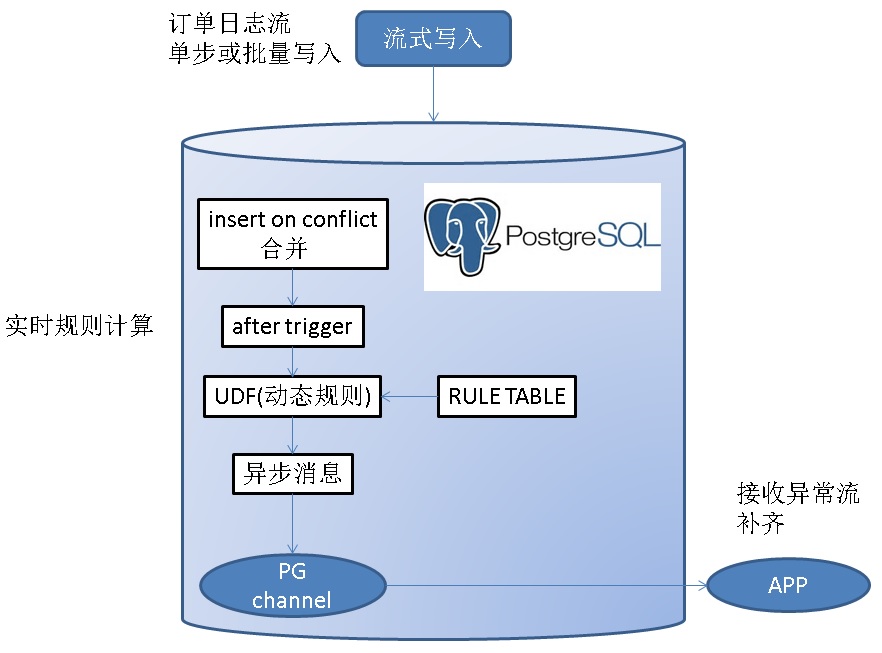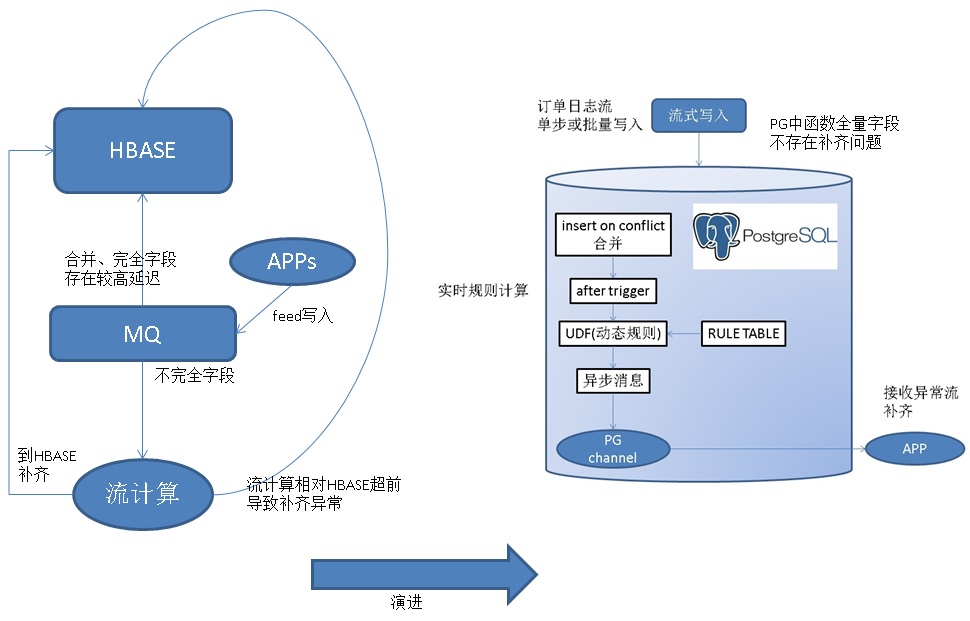PgSQL · 应用案例 · 流式计算与异步消息在阿里实时订单监测中的应用
Author: digoal
背景
在很多业务系统中,为了定位问题、运营需要、分析需要或者其他需求,会在业务中设置埋点,记录用户的行为在业务系统中产生的日志,也叫FEED日志。
比如订单系统、在业务系统中环环相扣,从购物车、下单、付款、发货,收货(还有纠纷、退款等等),一笔订单通常会产生若干相关联的记录。
每个环节产生的属性可能是不一样的,有可能有新的属性产生,也有可能变更已有的属性值。
为了便于分析,通常有必要将订单在整个过程中产生的若干记录(若干属性),合并成一条记录(订单大宽表)。
通常业务系统会将实时产生的订单FEED数据写入消息队列,消息队列使得数据变成了流动的数据:
方案一、RDS PG + OSS + HDB PG 分钟清洗和主动检测
数据通过消息队列消费后,实时写入RDS PG,在RDS PG进行订单FEED的合并,写入OSS外部表。(支持压缩格式,换算成裸数据的写入OSS的速度约100MB/s/会话)
HDB PG从OSS外部表读取(支持压缩格式,换算成裸数据的读取OSS的速度约100MB/s/数据节点),并将订单FEED数据合并到全量订单表。

《打造云端流计算、在线业务、数据分析的业务数据闭环 - 阿里云RDS、HybridDB for PostgreSQL最佳实践》
数据进入HDB PG后,通过规则SQL,从全量订单表中,挖掘异常数据(或者分析)。
通过这种方案,实现了海量订单FEED数据的分钟级准实时分析。
这个方案已支撑了双十一业务,超高吞吐、低延迟,丝般柔滑。
方案二、毫秒级FEED监测及实时反馈方案
技术永远是为业务服务的,分钟级延迟虽然说已经很高了,但是在一些极端情况下,可能需要更低的延迟。
实际上RDS PostgreSQL还有更强的杀手锏,可以实现毫秒级的异常FEED数据发现和反馈。
流式处理+异步消息,方法如下:
1、通过触发机制结合异步消息通道实现。

2、通过pipeline,流式SQL结合异步消息通道实现。

应用程序监听消息通道(listen channel),数据库则将异常数据写入到消息通道(notify channel, message)。实现异常数据的主动异步推送。
毫秒级FEED监测与反馈架构设计
之前不做毫秒级的FEED监测,还有一个原因是HBASE的合并延迟较高,导致流计算在补齐字段时异常。使用RDS PG来实现异常监测,完全杜绝了补齐的问题,因为在RDS PG就包含了全字段,不存在补齐的需求。

RDS PG设计
1、分实例,提高系统级吞吐。(例如单实例处理能力是15万行/s,那么100个实例,可以支撑1500万行/s的实时处理。)
例如:
DB0, DB1, DB2, DB3, ..., DB255
映射关系:
db0, host?, port?
db1, host?, port?
...
2、实例内使用分表,提高单实例并行处理吞吐。当规则众多时,分表可以提高单实例的规则处理吞吐。
例如
tbl0, tbl1, tbl2, ..., tbl127
tbl128, tbl129, tbl130, ..., tbl255
映射关系:
tbl0, db?
tbl1, db?
...
HDB PG设计
HDB PG依旧保留,用于PB级数据量的海量数据实时分析。
数据通路依旧采用OSS,批量导入的方式。
DEMO
1、创建订单feed全宽表(当然,我们也可以使用jsonb字段来存储所有属性。因为PostgreSQL支持JSONB类型哦。PostgreSQL支持的多值类型还有hstore, xml等。)
create table feed(id int8 primary key, c1 int, c2 int, c3 int, c4 int, c5 int, c6 int, c7 int, c8 int, c9 int, c10 int, c11 int, c12 int);
2、订单FEED数据的写入,例如A业务系统,写入订单的c1,c2字段。B业务系统,写入订单的c3,c4字段。……
使用on conflict do something语法,进行订单属性的合并。
insert into feed (id, c1, c2) values (2,2,30001) on conflict (id) do update set c1=excluded.c1, c2=excluded.c2 ;
insert into feed (id, c3, c4) values (2,99,290001) on conflict (id) do update set c3=excluded.c3, c4=excluded.c4 ;
3、建立订单FEED的实时监测规则,当满足条件时,向PostgreSQL的异步消息中发送消息。监听该通道的APP,循环从异步消息获取数据,即可满足消息的实时消费。
规则可以保留在TABLE中,也可以写在触发器代码中,也可以写在UDF代码中。
3.1、如果数据是批量写入的,可以使用语句级触发器,降低触发器函数被调用的次数,提高写入吞吐。
create or replace function tg1() returns trigger as $$
declare
begin
-- 规则定义,实际使用时,可以联合规则定义表
-- c2大于1000时,发送异步消息
perform pg_notify('channel_1', 'Resone:c2 overflow::'||row_to_json(inserted)) from inserted where c2>1000;
-- 多个规则,写单个notify的方法。
-- perform pg_notify(
-- 'channel_1',
-- case
-- when c2>1000 then 'Resone:c2 overflow::'||row_to_json(inserted)
-- when c1>200 then 'Resone:c1 overflow::'||row_to_json(inserted)
-- end
-- )
-- from inserted
-- where
-- c2 > 1000
-- or c1 > 200;
-- 多个规则,可以写多个notify,或者合并成一个NOTIFY。
return null;
end;
$$ language plpgsql strict;
3.2、如果数据是单条写入的,可以使用行级触发器。(本例后面的压测使用这个)
create or replace function tg2() returns trigger as $$
declare
begin
-- 规则定义,实际使用时,可以联合规则定义表
-- c2大于9999时,发送异步消息
perform pg_notify('channel_1', 'Resone:c2 overflow::'||row_to_json(NEW)) where NEW.c2>9999;
-- 多个规则,调用单个notify,写一个CHANNEL的方法。
-- perform pg_notify(
-- 'channel_1',
-- case
-- when c2>1000 then 'Resone:c2 overflow::'||row_to_json(NEW)
-- when c1>200 then 'Resone:c1 overflow::'||row_to_json(NEW)
-- end
-- )
-- where
-- NEW.c2 > 10000
-- or NEW.c1 > 200;
-- 多个规则,调用单个notify,写多个CHANNEL的方法。
-- perform pg_notify(
-- case
-- when c2>1000 then 'channel_1'
-- when c1>200 then 'channel_2'
-- end,
-- case
-- when c2>1000 then 'Resone:c2 overflow::'||row_to_json(NEW)
-- when c1>200 then 'Resone:c1 overflow::'||row_to_json(NEW)
-- end
-- )
-- where
-- NEW.c2 > 1000
-- or NEW.c1 > 200;
-- 多个规则,可以写多个notify,或者合并成一个NOTIFY。
-- 例如
-- perform pg_notify('channel_1', 'Resone:c2 overflow::'||row_to_json(NEW)) where NEW.c2 > 1000;
-- perform pg_notify('channel_2', 'Resone:c1 overflow::'||row_to_json(NEW)) where NEW.c1 > 200;
-- 也可以把规则定义在TABLE里面,实现动态的规则
-- 规则不要过于冗长,否则会降低写入的吞吐,因为是串行处理规则。
-- udf的输入为feed类型以及rule_table类型,输出为boolean。判断逻辑定义在UDF中。
-- perfrom pg_notify(channel_column, resone_column||'::'||row_to_json(NEW)) from rule_table where udf(NEW::feed, rule_table);
return null;
end;
$$ language plpgsql strict;
3.3、如上代码中所述,规则可以定义在很多地方。
4、创建触发器。
4.1、语句级触发器(批量写入,建议采用)
create trigger tg1 after insert on feed REFERENCING NEW TABLE AS inserted for each statement execute procedure tg1();
create trigger tg2 after update on feed REFERENCING NEW TABLE AS inserted for each statement execute procedure tg1();
4.2、行级触发器(单步写入建议采用),(本例后面的压测使用这个)
create trigger tg1 after insert on feed for each row execute procedure tg2();
create trigger tg2 after update on feed for each row execute procedure tg2();
5、协商好通道名称。
6、应用端监听消息通道。
listen channel_1;
接收消息:
loop
sleep ?;
get 消息;
end loop
7、写入订单数据,每行数据都会实时过触发器,在触发器中写好了逻辑,当满足一些规则时,向协商好的消息通道发送消息。
postgres=# insert into feed (id, c1, c2) values (2,2,30001) on conflict (id) do update set c1=excluded.c1, c2=excluded.c2 ;
INSERT 0 1
8、接收到的消息样本如下:
Asynchronous notification "channel_1" with payload "Resone:c2 overflow::{"id":2,"c1":2,"c2":30001,"c3":null,"c4":null,"c5":null,"c6":null,"c7":null,"c8":null,"c9":null,"c10":null,"c11":null,"c12":null}" received from server process with PID 38445.
9、批量插入
postgres=# insert into feed (id, c1, c2) select id,random()*100, random()*1001 from generate_series(1,10000) t(id) on conflict (id) do update set c1=excluded.c1, c2=excluded.c2 ;
INSERT 0 10000
Time: 59.528 ms
一次接收到的样本如下:
Asynchronous notification "channel_1" with payload "Resone:c2 overflow::{"id":362,"c1":92,"c2":1001,"c3":null,"c4":null,"c5":null,"c6":null,"c7":null,"c8":null,"c9":null,"c10":null,"c11":null,"c12":null}" received from server process with PID 38445.
Asynchronous notification "channel_1" with payload "Resone:c2 overflow::{"id":4061,"c1":90,"c2":1001,"c3":null,"c4":null,"c5":null,"c6":null,"c7":null,"c8":null,"c9":null,"c10":null,"c11":null,"c12":null}" received from server process with PID 38445.
Asynchronous notification "channel_1" with payload "Resone:c2 overflow::{"id":4396,"c1":89,"c2":1001,"c3":null,"c4":null,"c5":null,"c6":null,"c7":null,"c8":null,"c9":null,"c10":null,"c11":null,"c12":null}" received from server process with PID 38445.
Asynchronous notification "channel_1" with payload "Resone:c2 overflow::{"id":5485,"c1":72,"c2":1001,"c3":null,"c4":null,"c5":null,"c6":null,"c7":null,"c8":null,"c9":null,"c10":null,"c11":null,"c12":null}" received from server process with PID 38445.
Asynchronous notification "channel_1" with payload "Resone:c2 overflow::{"id":6027,"c1":56,"c2":1001,"c3":null,"c4":null,"c5":null,"c6":null,"c7":null,"c8":null,"c9":null,"c10":null,"c11":null,"c12":null}" received from server process with PID 38445.
Asynchronous notification "channel_1" with payload "Resone:c2 overflow::{"id":6052,"c1":91,"c2":1001,"c3":null,"c4":null,"c5":null,"c6":null,"c7":null,"c8":null,"c9":null,"c10":null,"c11":null,"c12":null}" received from server process with PID 38445.
Asynchronous notification "channel_1" with payload "Resone:c2 overflow::{"id":7893,"c1":84,"c2":1001,"c3":null,"c4":null,"c5":null,"c6":null,"c7":null,"c8":null,"c9":null,"c10":null,"c11":null,"c12":null}" received from server process with PID 38445.
Asynchronous notification "channel_1" with payload "Resone:c2 overflow::{"id":8158,"c1":73,"c2":1001,"c3":null,"c4":null,"c5":null,"c6":null,"c7":null,"c8":null,"c9":null,"c10":null,"c11":null,"c12":null}" received from server process with PID 38445.
10、更新数据
postgres=# update feed set c1=1;
UPDATE 10000
Time: 33.444 ms
接收到的异步消息样本如下:
Asynchronous notification "channel_1" with payload "Resone:c2 overflow::{"id":1928,"c1":1,"c2":1001,"c3":null,"c4":null,"c5":null,"c6":null,"c7":null,"c8":null,"c9":null,"c10":null,"c11":null,"c12":null}" received from server process with PID 38445.
Asynchronous notification "channel_1" with payload "Resone:c2 overflow::{"id":2492,"c1":1,"c2":1001,"c3":null,"c4":null,"c5":null,"c6":null,"c7":null,"c8":null,"c9":null,"c10":null,"c11":null,"c12":null}" received from server process with PID 38445.
Asynchronous notification "channel_1" with payload "Resone:c2 overflow::{"id":2940,"c1":1,"c2":1001,"c3":null,"c4":null,"c5":null,"c6":null,"c7":null,"c8":null,"c9":null,"c10":null,"c11":null,"c12":null}" received from server process with PID 38445.
Asynchronous notification "channel_1" with payload "Resone:c2 overflow::{"id":2981,"c1":1,"c2":1001,"c3":null,"c4":null,"c5":null,"c6":null,"c7":null,"c8":null,"c9":null,"c10":null,"c11":null,"c12":null}" received from server process with PID 38445.
Asynchronous notification "channel_1" with payload "Resone:c2 overflow::{"id":4271,"c1":1,"c2":1001,"c3":null,"c4":null,"c5":null,"c6":null,"c7":null,"c8":null,"c9":null,"c10":null,"c11":null,"c12":null}" received from server process with PID 38445.
Asynchronous notification "channel_1" with payload "Resone:c2 overflow::{"id":4539,"c1":1,"c2":1001,"c3":null,"c4":null,"c5":null,"c6":null,"c7":null,"c8":null,"c9":null,"c10":null,"c11":null,"c12":null}" received from server process with PID 38445.
Asynchronous notification "channel_1" with payload "Resone:c2 overflow::{"id":7089,"c1":1,"c2":1001,"c3":null,"c4":null,"c5":null,"c6":null,"c7":null,"c8":null,"c9":null,"c10":null,"c11":null,"c12":null}" received from server process with PID 38445.
Asynchronous notification "channel_1" with payload "Resone:c2 overflow::{"id":7619,"c1":1,"c2":1001,"c3":null,"c4":null,"c5":null,"c6":null,"c7":null,"c8":null,"c9":null,"c10":null,"c11":null,"c12":null}" received from server process with PID 38445.
Asynchronous notification "channel_1" with payload "Resone:c2 overflow::{"id":8001,"c1":1,"c2":1001,"c3":null,"c4":null,"c5":null,"c6":null,"c7":null,"c8":null,"c9":null,"c10":null,"c11":null,"c12":null}" received from server process with PID 38445.
Asynchronous notification "channel_1" with payload "Resone:c2 overflow::{"id":8511,"c1":1,"c2":1001,"c3":null,"c4":null,"c5":null,"c6":null,"c7":null,"c8":null,"c9":null,"c10":null,"c11":null,"c12":null}" received from server process with PID 38445.
Asynchronous notification "channel_1" with payload "Resone:c2 overflow::{"id":8774,"c1":1,"c2":1001,"c3":null,"c4":null,"c5":null,"c6":null,"c7":null,"c8":null,"c9":null,"c10":null,"c11":null,"c12":null}" received from server process with PID 38445.
Asynchronous notification "channel_1" with payload "Resone:c2 overflow::{"id":9394,"c1":1,"c2":1001,"c3":null,"c4":null,"c5":null,"c6":null,"c7":null,"c8":null,"c9":null,"c10":null,"c11":null,"c12":null}" received from server process with PID 38445.
压测1 - 单步实时写入
1、假设每1万条记录中,有一条异常记录需要推送,这样的频率算是比较现实的。
vi test.sql
\set id random(1,10000000)
\set c1 random(1,1001)
\set c2 random(1,10000)
insert into feed (id, c1, c2) values (:id, :c1, :c2) on conflict (id) do update set c1=excluded.c1, c2=excluded.c2 ;
2、压测结果,16.7万 行/s 处理吞吐。
transaction type: ./test.sql
scaling factor: 1
query mode: prepared
number of clients: 56
number of threads: 56
duration: 120 s
number of transactions actually processed: 20060111
latency average = 0.335 ms
latency stddev = 0.173 ms
tps = 167148.009836 (including connections establishing)
tps = 167190.475312 (excluding connections establishing)
script statistics:
- statement latencies in milliseconds:
0.002 \set id random(1,10000000)
0.001 \set c1 random(1,1001)
0.000 \set c2 random(1,10000)
0.332 insert into feed (id, c1, c2) values (:id, :c1, :c2) on conflict (id) do update set c1=excluded.c1, c2=excluded.c2 ;
3、监听到的异步消息采样
postgres=# listen channel_1;
LISTEN
Asynchronous notification "channel_1" with payload "Resone:c2 overflow::{"id":3027121,"c1":393,"c2":10000,"c3":null,"c4":null,"c5":null,"c6":null,"c7":null,"c8":null,"c9":null,"c10":null,"c11":null,"c12":null}" received from server process with PID 738.
Asynchronous notification "channel_1" with payload "Resone:c2 overflow::{"id":5623104,"c1":177,"c2":10000,"c3":null,"c4":null,"c5":null,"c6":null,"c7":null,"c8":null,"c9":null,"c10":null,"c11":null,"c12":null}" received from server process with PID 758.
Asynchronous notification "channel_1" with payload "Resone:c2 overflow::{"id":3850742,"c1":365,"c2":10000,"c3":null,"c4":null,"c5":null,"c6":null,"c7":null,"c8":null,"c9":null,"c10":null,"c11":null,"c12":null}" received from server process with PID 695.
Asynchronous notification "channel_1" with payload "Resone:c2 overflow::{"id":5244809,"c1":55,"c2":10000,"c3":null,"c4":null,"c5":null,"c6":null,"c7":null,"c8":null,"c9":null,"c10":null,"c11":null,"c12":null}" received from server process with PID 716.
Asynchronous notification "channel_1" with payload "Resone:c2 overflow::{"id":4062585,"c1":380,"c2":10000,"c3":null,"c4":null,"c5":null,"c6":null,"c7":null,"c8":null,"c9":null,"c10":null,"c11":null,"c12":null}" received from server process with PID 722.
Asynchronous notification "channel_1" with payload "Resone:c2 overflow::{"id":8536437,"c1":560,"c2":10000,"c3":null,"c4":null,"c5":null,"c6":null,"c7":null,"c8":null,"c9":null,"c10":null,"c11":null,"c12":null}" received from server process with PID 695.
Asynchronous notification "channel_1" with payload "Resone:c2 overflow::{"id":7327211,"c1":365,"c2":10000,"c3":null,"c4":null,"c5":null,"c6":null,"c7":null,"c8":null,"c9":null,"c10":null,"c11":null,"c12":null}" received from server process with PID 728.
Asynchronous notification "channel_1" with payload "Resone:c2 overflow::{"id":431739,"c1":824,"c2":10000,"c3":null,"c4":null,"c5":null,"c6":null,"c7":null,"c8":null,"c9":null,"c10":null,"c11":null,"c12":null}" received from server process with PID 731.
单实例分表的schemaless设计
请参考如下用法或案例,目的是自动建表,自动分片。
《PostgreSQL 在铁老大订单系统中的schemaless设计和性能压测》
《PostgreSQL 按需切片的实现(TimescaleDB插件自动切片功能的plpgsql schemaless实现)》
《PostgreSQL 时序最佳实践 - 证券交易系统数据库设计 - 阿里云RDS PostgreSQL最佳实践》
压测2 - 单实例分表实时写入
1、创建订单feed全宽表模板表
create table feed(id int8 primary key, c1 int, c2 int, c3 int, c4 int, c5 int, c6 int, c7 int, c8 int, c9 int, c10 int, c11 int, c12 int);
2、定义规则
create or replace function tg() returns trigger as $$
declare
begin
-- c2大于9999时,发送异步消息,
perform pg_notify('channel_1', 'Resone:c2 overflow::'||row_to_json(NEW)) where NEW.c2>9999;
-- 写入各个通道的例子,通过trigger parameter传入通道后缀(也可以写入单一通道,具体看设计需求)
-- perform pg_notify('channel_'||TG_ARGV[0], 'Resone:c2 overflow::'||row_to_json(NEW)) where NEW.c2>9999;
return null;
end;
$$ language plpgsql strict;
3、定义分表
do language plpgsql $$
declare
begin
for i in 1..512 loop
execute 'create table feed'||i||'(like feed including all) inherits (feed)';
-- 创建触发器(采用行级触发) , 本例采用静态规则(when (...)),实际使用请使用动态规则,处理所有行
execute 'create trigger tg1 after insert on feed'||i||' for each row WHEN (NEW.c2>9999) execute procedure tg()';
execute 'create trigger tg2 after update on feed'||i||' for each row WHEN (NEW.c2>9999) execute procedure tg()';
end loop;
end;
$$;
4、定义动态写入分表UDF(这个逻辑可以在应用层实现,本例只是演示单实例分表后的写吞吐能达到多少)
单条提交。
create or replace function ins(int,int8,int,int) returns void as $$
declare
begin
execute format('insert into feed%s (id,c1,c2) values (%s,%s,%s) on conflict (id) do update set c1=excluded.c1, c2=excluded.c2', $1, $2, $3, $4) ;
end;
$$ language plpgsql strict;
批量提交。
create or replace function ins(int, int8) returns void as $$
declare
begin
execute format('insert into feed%s (id,c1,c2) %s on conflict (id) do update set c1=excluded.c1, c2=excluded.c2', $1, 'select id, random()*100, random()*10000 from generate_series('||$1||','||$1+1000||') t (id)') ;
end;
$$ language plpgsql strict;
5、假设每1万条记录中,有一条异常记录需要推送,这样的频率算是比较现实的。
单条提交。
vi test.sql
\set suffix random(1,512)
\set id random(1,10000000)
\set c1 random(1,1001)
\set c2 random(1,10000)
select ins(:suffix, :id, :c1, :c2);
批量提交。
vi test.sql
\set suffix random(1,512)
\set id random(1,10000000)
select ins(:suffix, :id);
6、压测结果
单条提交, 15万 行/s处理吞吐。
相比单表单步写入略低,原因是采用了动态SQL(在UDF拼接分表),这部分逻辑放到APP端,性能有20%的提升。
transaction type: ./test.sql
scaling factor: 1
query mode: prepared
number of clients: 112
number of threads: 112
duration: 120 s
number of transactions actually processed: 18047334
latency average = 0.744 ms
latency stddev = 0.450 ms
tps = 150264.463046 (including connections establishing)
tps = 150347.026261 (excluding connections establishing)
script statistics:
- statement latencies in milliseconds:
0.002 \set suffix random(1,512)
0.001 \set id random(1,10000000)
0.001 \set c1 random(1,1001)
0.000 \set c2 random(1,10000)
0.742 select ins(:suffix, :id, :c1, :c2);
批量提交(1000行/批),117万 行/s处理吞吐。
批量提交有了质的提升。
transaction type: ./test.sql
scaling factor: 1
query mode: prepared
number of clients: 56
number of threads: 56
duration: 120 s
number of transactions actually processed: 140508
latency average = 47.820 ms
latency stddev = 17.175 ms
tps = 1169.851558 (including connections establishing)
tps = 1170.150203 (excluding connections establishing)
script statistics:
- statement latencies in milliseconds:
0.002 \set suffix random(1,512)
0.000 \set id random(1,10000000)
47.821 select ins(:suffix, :id);
jdbc 异步消息使用例子
https://jdbc.postgresql.org/documentation/81/listennotify.html
import java.sql.*;
public class NotificationTest {
public static void main(String args[]) throws Exception {
Class.forName("org.postgresql.Driver");
String url = "jdbc:postgresql://localhost:5432/test";
// Create two distinct connections, one for the notifier
// and another for the listener to show the communication
// works across connections although this example would
// work fine with just one connection.
Connection lConn = DriverManager.getConnection(url,"test","");
Connection nConn = DriverManager.getConnection(url,"test","");
// Create two threads, one to issue notifications and
// the other to receive them.
Listener listener = new Listener(lConn);
Notifier notifier = new Notifier(nConn);
listener.start();
notifier.start();
}
}
class Listener extends Thread {
private Connection conn;
private org.postgresql.PGConnection pgconn;
Listener(Connection conn) throws SQLException {
this.conn = conn;
this.pgconn = (org.postgresql.PGConnection)conn;
Statement stmt = conn.createStatement();
stmt.execute("LISTEN mymessage");
stmt.close();
}
public void run() {
while (true) {
try {
// issue a dummy query to contact the backend
// and receive any pending notifications.
Statement stmt = conn.createStatement();
ResultSet rs = stmt.executeQuery("SELECT 1");
rs.close();
stmt.close();
org.postgresql.PGNotification notifications[] = pgconn.getNotifications();
if (notifications != null) {
for (int i=0; i<notifications.length; i++) {
System.out.println("Got notification: " + notifications[i].getName());
}
}
// wait a while before checking again for new
// notifications
Thread.sleep(500);
} catch (SQLException sqle) {
sqle.printStackTrace();
} catch (InterruptedException ie) {
ie.printStackTrace();
}
}
}
}
class Notifier extends Thread {
private Connection conn;
public Notifier(Connection conn) {
this.conn = conn;
}
public void run() {
while (true) {
try {
Statement stmt = conn.createStatement();
stmt.execute("NOTIFY mymessage");
stmt.close();
Thread.sleep(2000);
} catch (SQLException sqle) {
sqle.printStackTrace();
} catch (InterruptedException ie) {
ie.printStackTrace();
}
}
}
}
libpq 异步消息的使用方法
https://www.postgresql.org/docs/10/static/libpq-notify.html
触发器的用法
https://www.postgresql.org/docs/10/static/sql-createtrigger.html
注意事项
1、异步消息快速接收,否则会占用实例 $PGDATA/pg_notify 的目录空间。
2、异步消息上限,没有上限,和存储有个。
buffer大小:
/*
* The number of SLRU page buffers we use for the notification queue.
*/
#define NUM_ASYNC_BUFFERS 8
3、异步消息可靠性,每个异步消息通道,PG都会跟踪监听这个通道的会话已接收到的消息的位置偏移。
新发起的监听,只从监听时该通道的最后偏移开始发送,该偏移之前的消息不会被发送。
消息接收后,如果没有任何监听需要,则会被清除。
监听消息通道的会话,需要持久化,也就是说会话断开的话,(未接收的消息,以及到会话重新监听这段时间,新产生的消息,都收不到)
4、如果需要强可靠性(替换掉异步消息,使用持久化的模式)
方法:触发器内pg_notify改成insert into feedback_table ....;
持久化消息的消费方法,改成如下(阅后即焚模式):
with t1 as (select ctid from feedback_table order by crt_time limit 100)
delete from feedback_table where
ctid = any (array(select ctid from t1))
returning *;
持久化消息,一样能满足10万行以上的消费能力(通常异常消息不会那么多,所以这里可以考虑使用单个异常表,多个订单表)。
只不过会消耗更多的RDS PG的IOPS,(产生写 WAL,VACUUM WAL。)
其他
1、已推送的异常,当数据更新后,可能会被再次触发,通过在逻辑中对比OLD value和NEW value可以来规避这个问题。本文未涉及。实际使用是可以改写触发器代码。
实时计算处理吞吐
1、RDS PostgreSQL 单实例处理吞吐达到了 117万 行/s。性价比超级棒。
2、100个RDS PostgreSQL,可以轻松达到 1亿 行/s (60亿/分钟) 的处理吞吐。宇宙无敌了。
参考
《在PostgreSQL中实现update | delete limit - CTID扫描实践 (高效阅后即焚)》
《(流式、lambda、触发器)实时处理大比拼 - 物联网(IoT)\金融,时序处理最佳实践》
《PostgreSQL 10.0 preview 功能增强 - 触发器函数内置中间表》
https://www.postgresql.org/docs/10/static/sql-createtrigger.html
https://jdbc.postgresql.org/documentation/81/listennotify.html